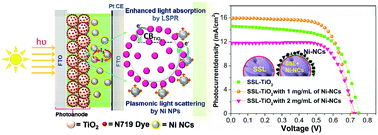当前位置:
X-MOL 学术
›
Inorg. Chem. Front.
›
论文详情
Our official English website, www.x-mol.net, welcomes your
feedback! (Note: you will need to create a separate account there.)
Microwave-solvothermal synthesis of various TiO2 nano-morphologies with enhanced efficiency by incorporating Ni nanoparticles in an electrolyte for dye-sensitized solar cells
Inorganic Chemistry Frontiers ( IF 6.1 ) Pub Date : 2017-08-14 00:00:00 , DOI: 10.1039/c7qi00329c R. Krishnapriya 1, 2, 3, 4, 5 , S. Praneetha 1, 2, 3, 4, 5 , A. Vadivel Murugan 1, 2, 3, 4, 5
Inorganic Chemistry Frontiers ( IF 6.1 ) Pub Date : 2017-08-14 00:00:00 , DOI: 10.1039/c7qi00329c R. Krishnapriya 1, 2, 3, 4, 5 , S. Praneetha 1, 2, 3, 4, 5 , A. Vadivel Murugan 1, 2, 3, 4, 5
Affiliation

|
Dye-sensitized solar cells (DSSCs) have been fabricated with various nanostructured TiO2 morphologies, including interconnected beads-like (IBL), square platelets-like (SPL), spindle shape-like (SSL), and porous spheres-like (PSL), synthesized in different solvents (ethanol, mixture of ethanol + H2O and HF), and size and shape-tuned Ni-NCs of mixed triangular and hexagonal morphological crystals with sizes ranging from 15 to 62 nm in ethylene glycol (polyol) medium. These different TiO2 and Ni-NCs were constructed via a rapid, facile microwave-assisted solvothermal (MW-ST) route. The application potential of these TiO2 NCs as photoanodes unveiled excellent morphology-dependent PCEs (5.3% to 9.33%) using a conventional electrolyte and N719 dye as a photosensitizer. Subsequently, after impregnating Ni-NCs in the I−/I3− electrolyte, the nanoparticles on the surface of each TiO2 morphology acted as excellent scattering centers to provide a potential interface between TiO2 and Ni-NCs and enhance both light absorption and scattering, leading to improvements in the PCEs to 5.8%, 8.37%, 9.19% and 10.02% for the PSL, SSL, SPL and IBL-based photoanodes, respectively. This enhanced PCE was accomplished by systematic optimization of factors such as the surface morphology of the TiO2 photoanode and the size and concentration of the Ni-NCs in the electrolyte to attain the best advantages of scattering-induced effective light utilization and size-mismatching effects at the photoanode and Ni-NCs integrated electrolyte interface. The incorporated Ni-NCs effectively trap incident light and successively improve the rate of electron–hole pair formation and short circuit current (Jsc); they also exhibit excellent stability in the conventional I−/I3− electrolyte over a period of 30 days.
中文翻译:

通过将镍纳米粒子掺入染料敏化太阳能电池的电解质中,微波溶剂热合成各种TiO 2纳米形态,并提高了效率
染料敏化太阳能电池(DSSC)具有各种纳米结构的TiO 2形态,包括相互连接的珠状(IBL),正方形血小板状(SPL),纺锤状形状(SSL)和多孔球状(PSL) ),在不同的溶剂(乙醇,乙醇+ H 2 O和HF的混合物)中合成,以及在乙二醇(多元醇)中混合形成15至62 nm大小的三角形和六边形混合形态晶体的尺寸和形状调整后的Ni-NC中等的。这些不同的TiO 2和Ni-NCs是通过快速,便捷的微波辅助溶剂热(MW-ST)路线构建的。这些TiO 2的应用潜力NCs作为光阳极,使用常规电解质和N719染料作为光敏剂,揭示了优异的形态学依赖性PCE(5.3%至9.33%)。接着,在I浸渍镍的NC后- / I 3 -电解质,每个TiO 2的表面上的纳米颗粒2充当优良的散射中心的形态,以提供二氧化钛之间的电位接口2和Ni-NCS和同时提高光吸收和散射,基于PSL,SSL,SPL和IBL的光阳极的PCE分别提高到5.8%,8.37%,9.19%和10.02%。这种增强的PCE是通过系统优化诸如TiO 2的表面形态等因素来实现的光电阳极以及电解质中Ni-NC的尺寸和浓度,以获得在光电阳极和Ni-NCs集成电解质界面处散射诱导的有效光利用和尺寸失配效应的最佳优势。内置的Ni-NC可以有效地捕获入射光,并依次提高电子-空穴对的形成速度和短路电流(J sc)。它们还表现出在常规的I优良的稳定性- / I 3 -电解质历时30天。
更新日期:2017-08-29
中文翻译:

通过将镍纳米粒子掺入染料敏化太阳能电池的电解质中,微波溶剂热合成各种TiO 2纳米形态,并提高了效率
染料敏化太阳能电池(DSSC)具有各种纳米结构的TiO 2形态,包括相互连接的珠状(IBL),正方形血小板状(SPL),纺锤状形状(SSL)和多孔球状(PSL) ),在不同的溶剂(乙醇,乙醇+ H 2 O和HF的混合物)中合成,以及在乙二醇(多元醇)中混合形成15至62 nm大小的三角形和六边形混合形态晶体的尺寸和形状调整后的Ni-NC中等的。这些不同的TiO 2和Ni-NCs是通过快速,便捷的微波辅助溶剂热(MW-ST)路线构建的。这些TiO 2的应用潜力NCs作为光阳极,使用常规电解质和N719染料作为光敏剂,揭示了优异的形态学依赖性PCE(5.3%至9.33%)。接着,在I浸渍镍的NC后- / I 3 -电解质,每个TiO 2的表面上的纳米颗粒2充当优良的散射中心的形态,以提供二氧化钛之间的电位接口2和Ni-NCS和同时提高光吸收和散射,基于PSL,SSL,SPL和IBL的光阳极的PCE分别提高到5.8%,8.37%,9.19%和10.02%。这种增强的PCE是通过系统优化诸如TiO 2的表面形态等因素来实现的光电阳极以及电解质中Ni-NC的尺寸和浓度,以获得在光电阳极和Ni-NCs集成电解质界面处散射诱导的有效光利用和尺寸失配效应的最佳优势。内置的Ni-NC可以有效地捕获入射光,并依次提高电子-空穴对的形成速度和短路电流(J sc)。它们还表现出在常规的I优良的稳定性- / I 3 -电解质历时30天。











































 京公网安备 11010802027423号
京公网安备 11010802027423号